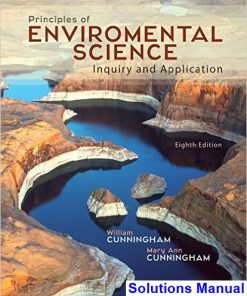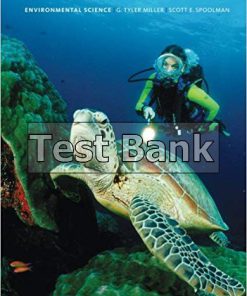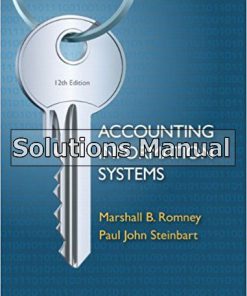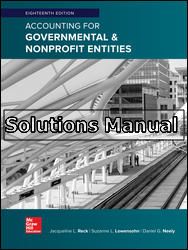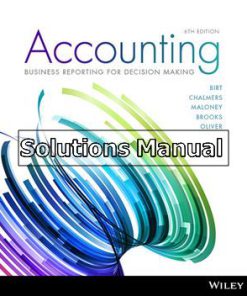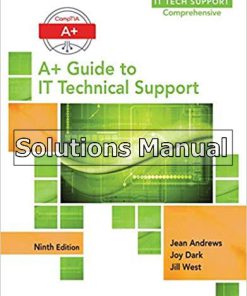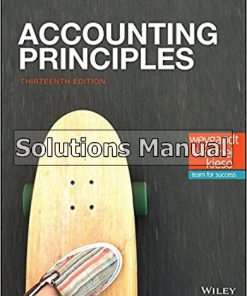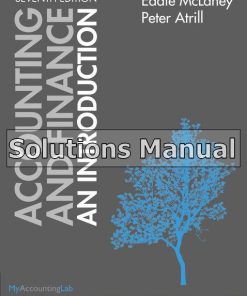Environmental Science 16th Edition Miller Solutions Manual
You may also like
This is completed downloadable of Environmental Science 16th Edition Miller Solutions Manual

Product Details:
- ISBN-10 : 9781337569613
- ISBN-13 : 978-1337569613
- Author: Tyler Miller, Scott Spoolman
The 16th Edition of ENVIRONMENTAL SCIENCE is “inspiring people to care about the planet.” Partnering with National Geographic Learning, the authors Tyler Miller and Scott Spoolman deliver a text that equips and inspires you with the tools and knowledge to make a difference solving today’s environmental issues. Exclusive content highlights important work of National Geographic explorers and grantees and features vivid photos, maps and illustrations that bring course concepts to life. Using sustainability as their central theme, the authors emphasize natural capital, natural capital degradation, solutions, trade-offs and the importance of individuals. In return, you learn how nature works, how you interact with it and how humanity can continue to sustain its relationship with the earth by applying nature’s lessons to economies and individual lifestyles.
Table of Content:
- Chapter 1: The Environment and Sustainability
- 1.1 What Are Some Key Principles of Sustainability?
- 1.2 How Are We Affecting the Earth?
- 1.3 What Causes Environmental Problems?
- 1.4 What Is an Environmentally Sustainable Society?
- Chapter Review
- Critical Thinking
- Doing Environmental Science
- Global Environment Watch Exercise
- Ecological Footprint Analysis
- Ecology and Sustainability
- Chapter 2: Science, Matter, Energy, and Systems
- 2.1 What Do Scientists Do?
- 2.2 What Is Matter and What Happens When It Undergoes Change?
- 2.3 What Is Energy and What Happens When It Undergoes Change?
- 2.4 What Are Systems and How Do They Respond to Change?
- Chapter Review
- Critical Thinking
- Doing Environmental Science
- Global Environmental Watch Exercise
- Data Analysis
- Chapter 3: Ecosystems: What Are They and How Do They Work?
- 3.1 How Does the Earth’s Life-Support System Work?
- 3.2 What Are the Major Components of an Ecosystem?
- 3.3 What Happens to Energy in an Ecosystem?
- 3.4 What Happens to Matter in an Ecosystem?
- 3.5 How Do Scientists Study Ecosystems?
- Chapter Review
- Critical Thinking
- Doing Environmental Science
- Global Environment Watch Exercise
- Data Analysis
- Chapter 4: Biodiversity and Evolution
- 4.1 What Is Biodiversity and Why Is It Important?
- 4.2 What Roles Do Species Play in Ecosystems?
- 4.3 How Does the Earth’s Life Change over Time?
- 4.4 What Factors Affect Biodiversity?
- Chapter Review
- Critical Thinking
- Doing Environmental Science
- Global Environment Watch Exercise
- Data Analysis
- Chapter 5: Species Interactions, Ecological Succession, and Population Control
- 5.1 How Do Species Interact?
- 5.2 How Do Communities and Ecosystems Respond to Changing Environmental Conditions?
- 5.3 What Limits the Growth of Populations?
- Chapter Review
- Critical Thinking
- Doing Environmental Science
- Global Environment Watch Exercise
- Data Analysis
- Chapter 6: The Human Population and Urbanization
- 6.1 How Many People Can the Earth Support?
- 6.2 What Factors Influence the Size of the Human Population?
- 6.3 How Does a Population’s Age Structure Affect Its Growth or Decline?
- 6.4 How Can We Slow Human Population Growth?
- 6.5 What Are the Major Urban Resource and Environmental Problems?
- 6.6 How Does Transportation Affect Urban Environmental Impacts?
- 6.7 How Can We Make Cities More Sustainable and Livable?
- Chapter Review
- Critical Thinking
- Doing Environmental Science
- Global Environment Watch Exercise
- Data Analysis
- Chapter 7: Climate and Biodiversity
- 7.1 What Factors Influence Climate?
- 7.2 What Are the Major Terrestrial Ecosystems and How Are Human Activities Affecting Them?
- 7.3 What Are the Major Types of Marine Aquatic Systems and How Are Human Activities Affecting Them?
- 7.4 What Are the Major Types of Freshwater Systems and How Are Human Activities Affecting Them?
- Chapter Review
- Critical Thinking
- Doing Environmental Science
- Global Environment Watch Exercise
- Data Analysis
- Sustaining Biodiversity
- Chapter 8: Sustaining Biodiversity: Saving Species
- 8.1 What Role Do Humans Play in the Loss of Species and Ecosystem Services?
- 8.2 Why Should We Try to Sustain Wild Species and the Ecosystem Services They Provide?
- 8.3 How Do Humans Accelerate Species Extinction and Degradation of Ecosystem Services?
- 8.4 How Can We Sustain Wild Species and the Ecosystem Services They Provide?
- Chapter Review
- Critical Thinking
- Doing Environmental Science
- Global Environment Watch Exercise
- Data Analysis
- Chapter 9: Sustaining Biodiversity: Saving Ecosystems
- 9.1 What Are the Major Threats to Forest Ecosystems?
- 9.2 How Can We Manage and Sustain Forests?
- 9.3 How Can We Manage and Sustain Grasslands?
- 9.4 How Can We Sustain Terrestrial Biodiversity?
- 9.5 How Can We Sustain Aquatic Biodiversity?
- Chapter Review
- Critical Thinking
- Doing Environmental Science
- Global Environment Watch Exercise
- Ecological Footprint Analysis
- Sustaining Resources and Environmental Quality
- Chapter 10: Food Production and the Environment
- 10.1 What Is Food Security and Why Is It Difficult to Attain?
- 10.2 How Is Food Produced?
- 10.3 What Are the Environmental Effects of Industrialized Food Production?
- 10.4 How Can We Protect Crops from Pests More Sustainably?
- 10.5 How Can We Produce Food More Sustainably?
- 10.6 How Can We Improve Food Security?
- Chapter Review
- Critical Thinking
- Doing Environmental Science
- Global Environment Watch Exercise
- Ecological Footprint Analysis
- Chapter 11: Water Resources and Water Pollution
- 11.1 Will We Have Enough Usable Water?
- 11.2 How Can We Increase Freshwater Supplies?
- 11.3 How Can We Use Freshwater More Sustainably?
- 11.4 How Can We Reduce Water Pollution?
- Chapter Review
- Critical Thinking
- Doing Environmental Science
- Global Environment Watch Exercise
- Data Analysis
- Chapter 12: Geology and Nonrenewable Mineral Resources
- 12.1 What Are the Earth’s Major Geological Processes and What Are Mineral Resources?
- 12.2 How Long Might Supplies of Nonrenewable Mineral Resources Last?
- 12.3 What Are the Environmental Effects of Using Nonrenewable Mineral Resources?
- 12.4 How Can We Use Mineral Resources More Sustainably?
- 12.5 What Are the Earth’s Major Geological Hazards?
- Chapter Review
- Critical Thinking
- Doing Environmental Science
- Global Environment Watch Exercise
- Data Analysis
- Chapter 13: Energy Resources
- 13.1 What Is Net Energy and Why Is It Important?
- 13.2 What Are the Advantages and Disadvantages of Using Fossil Fuels?
- 13.3 What Are the Advantages and Disadvantages of Using Nuclear Power?
- 13.4 Why Is Energy Efficiency an Important Energy Resource?
- 13.5 What Are the Advantages and Disadvantages of Using Renewable Energy Resources?
- 13.6 How Can We Make the Transition to a More Sustainable Energy Future?
- Chapter Review
- Critical Thinking
- Doing Environmental Science
- Global Environment Watch Exercise
- Ecological Footprint Analysis
- Chapter 14: Environmental Hazards and Human Health
- 14.1 What Major Health Hazards Do We Face?
- 14.2 How Do Biological Hazards Threaten Human Health?
- 14.3 How Do Chemical Hazards Threaten Human Health?
- 14.4 How Can We Evaluate Risks from Chemical Hazards?
- 14.5 How Do We Perceive and Avoid Risks?
- Chapter Review
- Critical Thinking
- Doing Environmental Science
- Global Environment Watch Exercise
- Data Analysis
- Chapter 15: Air Pollution, Climate Change, and Ozone Depletion
- 15.1 What Is the Nature of the Atmosphere?
- 15.2 What Are the Major Air Pollution Problems?
- 15.3 How Should We Deal with Air Pollution?
- 15.4 How and Why Is the Earth’s Climate Changing?
- 15.5 What Are the Likely Effects of Climate Change?
- 15.6 How Can We Slow Climate Change?
- 15.7 How Have We Depleted Ozone in the Stratosphere and What Can We Do about It?
- Chapter Review
- Critical Thinking
- Doing Environmental Science
- Global Environment Watch Exercise
- Data Analysis
- Chapter 16: Solid and Hazardous Waste
- 16.1 What Environmental Problems Are Related to Solid and Hazardous Wastes?
- 16.2 How Should We Deal with Solid Waste?
- 16.3 Why Are Refusing, Reducing, Reusing, and Recycling So Important?
- 16.4 What Are the Advantages and Disadvantages of Burning or Burying Solid Waste?
- 16.5 How Should We Deal with Hazardous Waste?
- 16.6 How Can We Shift to a Low-Waste Economy?
- Chapter Review
- Critical Thinking
- Doing Environmental Science
- Global Environment Watch Exercise
- Ecological Footprint Analysis
- Sustaining Human Societies
- Chapter 17: Environmental Economics, Politics, and Worldviews
- 17.1 How Are Economic Systems Related to the Biosphere?
- 17.2 How Can We Use Economic Tools to Deal with Environmental Problems?
- 17.3 How Can We Implement More Sustainable and Just Environmental Policies?
- 17.4 What Are Some Major Environmental Worldviews?
- 17.5 How Can We Live More Sustainably?
- Chapter Review
- Critical Thinking
- Doing Environmental Science
- Global Environment Watch Exercise
- Ecological Footprint Analysis
- Glossary
- Index
People Also Search:
environmental science miller
environmental science 16th edition miller
environmental science
environmental science 16th edition
environmental science 16th edition download scribd
environmental science 16th edition solution manual download pdf
environmental science- miller and spoolman 16th edition pdf free




